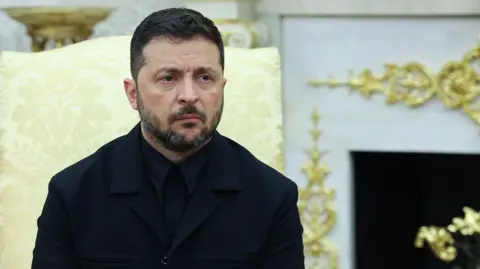In a recent meeting characterized by an air of diplomacy and cautious optimism, Ukrainian President Volodymyr Zelensky left the White House without major confrontations, signaling a potential thaw in relations amidst ongoing tensions. This encounter with U.S. President Donald Trump, held in August 2025, marked a sharp contrast to their previous meeting in February, which had been mired in allegations of misconduct and confrontation. The two leaders, despite their differences, appeared to navigate the discussion with a focus on collaboration, particularly concerning security and the ongoing conflict in Ukraine.
Zelensky, presenting himself in a sophisticated collared suit, was welcomed by Trump, who complimented his appearance. The Ukrainian leader’s willingness to express gratitude during the meeting seemed to contribute positively to the dynamics. In the Oval Office, however, Zelensky was somewhat reticent. His reluctance to speak suggested a careful approach, likely influenced by a desire not to contradict Trump’s expectations or undermine their partnership.
As the presidents addressed the media alongside European leaders, the apparent divergence in their viewpoints became evident. German Chancellor Friedrich Merz and French President Emmanuel Macron advocated for a ceasefire in Ukraine, emphasizing that such a halt should be prioritized. In contrast, Trump maintained that a ceasefire was premature until a more definitive resolution could be established. Zelensky’s silence at this moment was striking, hinting at the complexities involved in reconciling differing international perspectives on the war’s resolution.
Insights into the closed-door discussions were scarce; however, they seemingly revolved around vital security guarantees for Ukraine. The specifics of these discussions, including any potential plans for a direct meeting between Zelensky and Russian President Vladimir Putin, were not disclosed. Nevertheless, Zelensky underscored the importance of these security guarantees as a foundational step towards peace.
Expanding on security matters at a subsequent press conference, Zelensky outlined a significant potential deal with the U.S. worth approximately $90 billion. This agreement would likely involve military acquisitions, enhancing Ukraine’s defense capabilities with advanced aviation and missile systems. Moreover, Zelensky announced a plan for the U.S. to purchase Ukrainian drones, which would significantly aid in Ukraine’s domestic drone production efforts. While no formal agreements were in place, Zelensky expressed optimism that tangible progress could materialize within the next ten days.
In a notable shift, Zelensky was open about the prospect of engaging in talks with Putin, suggesting a meeting could be arranged, with Trump potentially partaking in the negotiations. This represented a departure from previous confrontations, showcasing Ukraine’s commitment to peace while reasserting its sovereignty. Zelensky confidently declared that Ukraine would persist in its pursuit of peace, alleviating fears about potential concessions on territorial integrity.
Interestingly, Zelensky raised the issue of territorial control, presenting a map to Trump that illustrated Russia’s limited territorial gains over the past three years. This revelation reportedly shifted Trump’s perspective during their discussions. The Ukrainian leader’s assertion that claims of extensive territorial loss were exaggerated highlighted an effort to manage perceptions regarding Ukraine’s resilience against ongoing aggression.
Overall, Zelensky emerged from the White House meeting feeling positive about the negotiations, which he described as “warm.” His deliberate optimism seemed geared towards fostering a more collaborative atmosphere conducive to aligning U.S. and European strategies on resolving the war. The primary takeaway from this visit, however, may be that Ukraine successfully secured additional time to bolster its defensive posture while navigating the delicate international landscape reshaped by shifting alliances and diplomatic engagements.
In conclusion, Zelensky’s U.S. visit was marked by a strategic blend of optimism and caution, strategically distancing Ukraine from conflicts that would jeopardize peace negotiations while reinforcing its commitment to territorial integrity. As international stakeholders continue to engage with the ongoing crisis in Ukraine, the conversations held at the White House will likely resonate in shaping future diplomatic efforts and potential resolutions to the protracted conflict.












